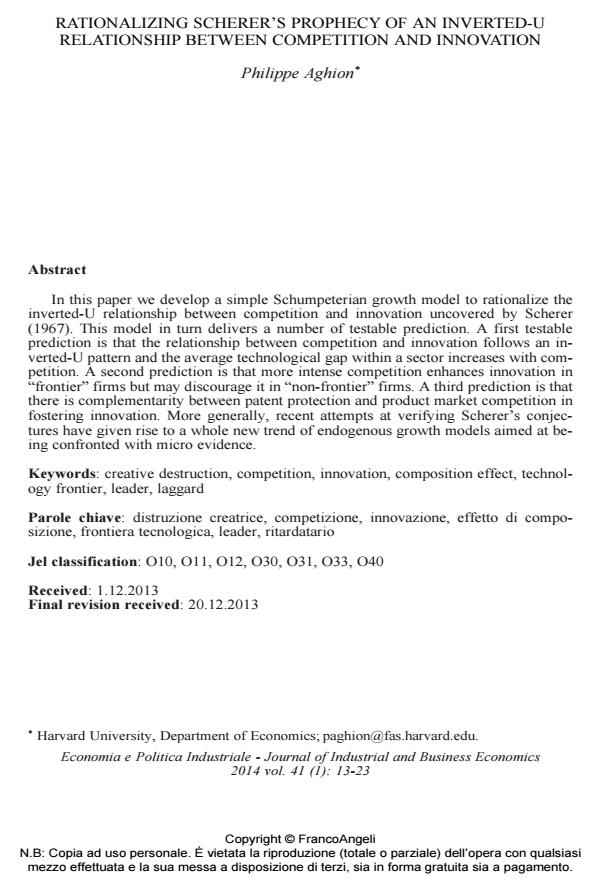Rationalizing Scherer’s prophecy of an inverted-U relationship between competition and innovation
Titolo Rivista ECONOMIA E POLITICA INDUSTRIALE
Autori/Curatori Philippe Aghion
Anno di pubblicazione 2014 Fascicolo 2014/1
Lingua Italiano Numero pagine 11 P. 13-23 Dimensione file 78 KB
DOI 10.3280/POLI2014-001002
Il DOI è il codice a barre della proprietà intellettuale: per saperne di più
clicca qui
Qui sotto puoi vedere in anteprima la prima pagina di questo articolo.
Se questo articolo ti interessa, lo puoi acquistare (e scaricare in formato pdf) seguendo le facili indicazioni per acquistare il download credit. Acquista Download Credits per scaricare questo Articolo in formato PDF

FrancoAngeli è membro della Publishers International Linking Association, Inc (PILA)associazione indipendente e non profit per facilitare (attraverso i servizi tecnologici implementati da CrossRef.org) l’accesso degli studiosi ai contenuti digitali nelle pubblicazioni professionali e scientifiche
In this paper we develop a simple Schumpeterian growth model to rationalize the inverted-U relationship between competition and innovation uncovered by Scherer (1967). This model in turn delivers a number of testable prediction. A first testable prediction is that the relationship between competition and innovation follows an inverted- U pattern and the average technological gap within a sector increases with competition. A second prediction is that more intense competition enhances innovation in "frontier" firms but may discourage it in "non-frontier" firms. A third prediction is that there is complementarity between patent protection and product market competition in fostering innovation. More generally, recent attempts at verifying Scherer’s conjectures have given rise to a whole new trend of endogenous growth models aimed at being confronted with micro evidence.
Parole chiave:Distruzione creatrice, competizione, innovazione, effetto di composizione, frontiera tecnologica, leader, ritardatario
Jel codes:O10, O11, O12, O30, O31, O33, O40
- Aghion P., Howitt P. 1992. a model of growth through creative destruction, Econometrica, 60 (2): 323-351, DOI: 10.2307/2951599
- Aghion P., Harris C., Vickers J. 1997. Competition and growth with step-by-step innovation: an example. European Economic Review, Papers and Proceedings, 41 (3-5): 771-782.
- Aghion P., Howitt P. 1998. Endogenous Growth Theory. Mit Press: Cambridge (Mass.).
- Aghion P., Harris C., Howitt P., Vickers J. 2001. Competition, imitation and growth with step-by-step innovation. Review of Economic Studies, 68 (3): 467-492, DOI: 10.1111/1467-937X.00177
- Aghion P., Bloom N., Blundell R., Griffith R., Howitt P. 2005. Competition and innovation: an inverted-U relationship. Quarterly Journal of Economics, 120 (2): 701-728, DOI: 10.1093/qje/120.2.701
- Aghion P., Griffith R. 2006. Competition and Growth: Reconciling Theory and Evidence. Mit Press: Cambridge (Mass.).
- Aghion P., Blundell R., Griffith R., Howitt P., Prantl S. 2009. The effects of entry on incumbent innovation and productivity. Review of Economics and Statistics, 91 (1): 20-32, DOI: 10.1162/rest.91.1.20
- Aghion P., Howitt P. 2009. The Economics of Growth. Mit Press: Cambridge (Mass.).
- Aghion P., Howitt P., Prantl S. 2012. Patent protection, product market reforms and innovative investments, mimeo.
- Aghion P., Bechtold S., Cassar L., Herz H. 2013. The effect of competition on innovation: experimental evidence, mimeo.
- Blundell R., Griffith R, Van Reenen J. 1995. Dynamic count data models of technological innovation. Economic Journal, 105 (429): 333-344, DOI: 10.2307/2235494
- Blundell R., Griffith R, Van Reenen J. 1999. Market share, market value and innovation in a panel of British manufacturing firms. Review of Economic Studies, 66 (3): 529-554, DOI: 10.1111/1467-937X.00097
- Boldrin M., Levine D. 2008. Against Intellectual Monopoly. Cambridge University Press: New york.
- Frankel J., Romer D. 1999. Does trade cause growth?. American Economic Review, 89 (3): 379-399, DOI: 10.1257/aer.89.3.379
- Grossman G., Helpman E. 1991. Quality ladders in the theory of growth. Review of Economic Studies, 58 (1): 43-61, DOI: 10.2307/2298044
- Hall B., Jaffe A., Trajtenberg M. 2001. The NBER patent citation data file: lessons, insights and methodological tools. NBER Working Paper 8498.
- Nickell S. 1996. Competition and corporate performance. Journal of Political Economy, 104 (4): 724-746, DOI: 10.1086/262040
- Qian y. 2007. Do national patent laws stimulate domestic innovation in a global patenting environment?. Review of Economics and Statistics, 89 (3): 436-453, DOI: 10.1162/rest.89.3.436
- Romer P. 1990. Endogenous technical change. Journal of Political Economy, 98 (5): 71-102, DOI: 10.1086/261725
- Scherer F.M. 1965. Firm size, market structure, opportunity, and the output of patented inventions. American Economic Review, 55 (5): 1097-1125.
- Scherer F.M. 1967. Market structure and the employment of scientists and engineers. American Economic Review, 57 (3): 524-531
- Schmutzler A. 2010. Is competition good for innovation? a simple approach to an unresolved question. Foundations and Trends in Microeconomic Analysis, 5 (6): 355-428, DOI: 10.1561/0700000035
- How does economic policy uncertainty affect corporate green innovation? Evidence from China Shengling Zhang, Zihao Wu, Wei Dou, Yu Hao, in Journal of Environmental Planning and Management /2025 pp.1363
DOI: 10.1080/09640568.2023.2286926 - History, statistics and theory: Frederic M. Scherer and modern industrial organization Giovanni B. Ramello, Francesco Silva, in ECONOMIA E POLITICA INDUSTRIALE 1/2014 pp.5
DOI: 10.3280/POLI2014-001001
Philippe Aghion, Rationalizing Scherer’s prophecy of an inverted-U relationship between competition and innovation in "ECONOMIA E POLITICA INDUSTRIALE " 1/2014, pp 13-23, DOI: 10.3280/POLI2014-001002